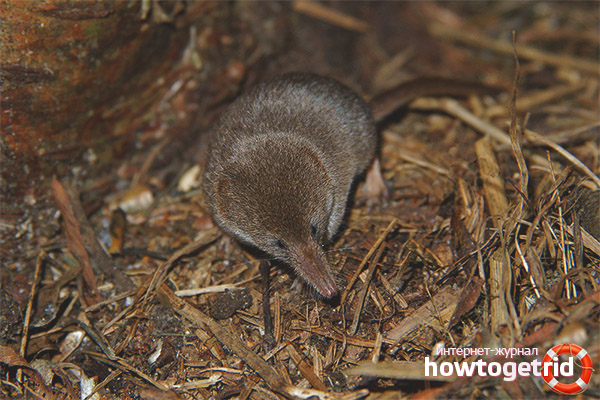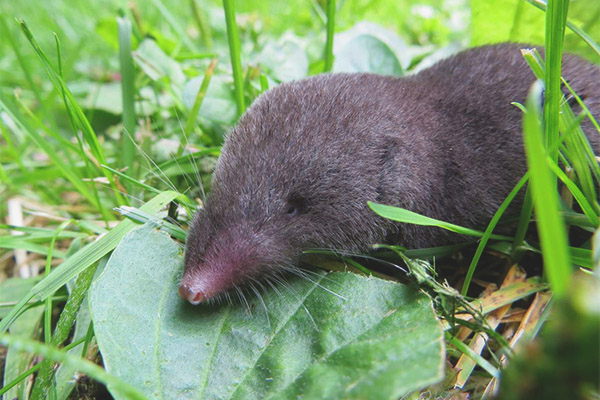The content of the article
Many animals are somewhat similar to other species. The same remark applies to the shrew that is very similar to the field mouse. And who is not familiar with the appearance of this family of shrews, when meeting a shrew will be somewhat discouraged: like a mouse, but very unusual, with an elongated muzzle, which is very similar to the proboscis, and its tail is very long, sometimes more than a small calf.
The appearance of the animal
Shrew - an ordinary animal, very small. Its size does not exceed 10 cm, weight - from 4 to 17 grams. But the hind legs are large, the length of the foot is from 1 to 1.5 cm.
The muzzle is elongated, gradually narrowing towards the nose. The eyes are small and round, the teeth are white. The tail can reach more than 7 cm, usually either completely bald, or may have several sparse short hairs.
The hair is velvety. The color in the upper part is always different in that it is darker: dark or black-brown, with lower shades lighter.In young individuals, the color is two-color, with a clearly defined border: the back is brown, the belly is gray. In the shrew already wintered on the sides there are reddish specks.
Species
Scientists decided to divide these earth-moving representatives into such subspecies, and now the following shrews exist:
- Ordinary. They are more common than others, occupying the territory of the northern part of Europe, where the climate is temperate. They live not only in mixed and deciduous forests, but also in the undergrowth, in the wet grass thickets, in bushes where the sun's rays rarely penetrate. Often settle in habitable dwellings of people, especially in places littered with plant debris.
- Giant. It is considered a rare species. Body length reaches 10 cm, weighs more than 14 grams. The muzzle has the shape of a cone, on which long silvery vibrations are clearly visible. The place to live in the forest chooses coniferous and broad-leaved forests, on the slopes of hills or in valleys. It is more common in the Far East, in the Primorsky Territory, in China and Korea. Very voracious - for the day eats 2.5 times more than it weighs.But for her it is not a problem due to the fact that the length of the intestine relative to the length of the body is very large. Moreover, it also prefers earthworms and Kipsyaks as food, other species do not recognize this food. But with a smaller appetite, it eats invertebrates and meat of other rodents, unlike its counterparts. Reproduction occurs once a year, very rarely twice - if the weather and conditions are favorable. More active compared to other shrews, especially at night. Scientists attribute this behavior to the fact that it feeds on earthworms, looking for a humus layer, the biomass of which is represented by worms, and such food is not distinguished by its nutritional value. Strong little legs are able to dig the ground well, so that the giant shrew can quickly hide into the soil, even if the surface is compacted. The whole process is accelerated: the animal digs with its front paws, and by hiding half, actively discards the ground with its hind legs.
- Small Lives throughout Europe, because it is otherwise called European. But also its habitats are Siberia, the Far East, Chukotka, Kyrgyzstan. Not more than 6 cm is the length of her body.The tail is also very long, but covered with thick and long hair. The general color is light reddish or brown.
- Tiny. This is the smallest type of shrew: dimensions do not exceed 5 cm, weight 4 grams. Her eyes and ears are so small that it is difficult to notice them under thick fur. And the tail, unlike other subspecies, is not so long. The hair on the body is short and velvety, in summer the color becomes much darker. Habitat zones are forest-tundra, forest zones and marginal areas of marshland. They live in vast territories, ranging from Sakhalin to the Scandinavian Peninsula. Must constantly, once every two hours, eat, otherwise she faces death. It is almost impossible to notice this crumb in the open area, because it moves in thick grass or under fallen leaves almost silently. And in the winter it can be on the surface if it cannot find insects in the soil because of the frozen ground. Many lovers to feast on tiny shrews bypass them, since they do not smell appetizing at all.
- Arctic. A resident of Siberia and North America, especially prefers to live in the tundra. In winter it has very thick, dense and light wool, in summer it is rare and inconspicuous. But constantly the colors have three different shades of brown.
- Alpine. Due to the small size of the Ukrainian Red Book, as it mainly lives in the Carpathians. Its main difference is that it has the longest tail: the length reaches an average of 7.5 cm. The fur on the back is very dark, has a brown tint, the belly is much lighter.
Lifestyle and nutrition

These animals live for about two years, but their lifestyle is very active, they move very quickly, and since their metabolism occurs quickly, the shrews need constant eating. Because of this, their sleep lasts no more than 10 - 15 minutes, because they can relax 80 times a day.
They live in burrows, but not in those that they dug themselves, but use the dwellings of other small animals or simply settle on a bed of grass and fallen leaves. The animal is very cautious, and its most active period begins just before sunset and at night. But even in the afternoon, the shrew hurries along the paved winding paths, and this is successfully helped by her agile tenacious legs and proboscis. Sometimes she uses those moves that made moles or mice.
This animal has poor eyesight, so good sense of touch and smell come to help. And in the dark, such a convenient natural gift, like echolocation, helps orient oneself.So, with the help of pulses, the shrew has an idea of the world around it and can find food. Unlike mice, they are insectivorous animals, and most often the food for them is in the upper soil layer. The diet consists of various bugs, slugs. Getting into the garden, the animal can destroy a large number of pests of cultivated plants - medvedka and leaf beetles, caterpillars and weevils, spiders, etc. He also eats bird droppings and carrion, snails and millipedes, seeds of plants.
During the meal, the shrew stands on all its feet. However, sometimes you have to hold the prey, then it is done by the front paws. To find something tasty, it can climb the tree, especially it attracts silkworm eggs. If there is a competitor for food, even larger, the shrew is not afraid to attack. Eats small animals, the animal almost completely, leaving the skin and bones.
Reproduction of offspring
Pregnancy lasts up to 4 weeks, and while there are no babies, there is an active preparation for the postpartum period.The future mother builds a nest, finding a safe place in the crevices of stones or among the roots of trees, in tall grass. A building material such as leaves and moss is used.
Children are born 3 - 9 in the litter. They are very helpless, blind and naked. For three weeks, the mother feeds them only with breast milk. After two weeks, they begin to coat and see. And after 120 - 160 can reproduce offspring.
Video: shrew (Sorex)











To send